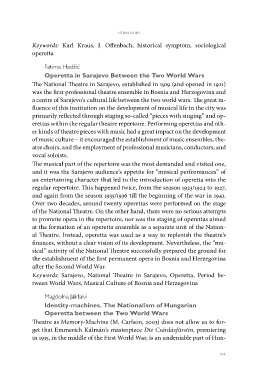Page 557 - Weiss, Jernej, ur./ed. 2021. Opereta med obema svetovnima vojnama ▪︎ Operetta between the Two World Wars. Koper/Ljubljana: Založba Univerze na Primorskem in Festival Ljubljana. Studia musicologica Labacensia, 5
P. 557
summaries
Keywords: Karl Kraus, J. Offenbach, historical symptom, sociological
operetta
Fatima Hadžić
Operetta in Sarajevo Between the Two World Wars
The National Theatre in Sarajevo, established in 1919 (and opened in 1921)
was the first professional theatre ensemble in Bosnia and Herzegovina and
a centre of Sarajevo’s cultural life between the two world wars. The great in-
fluence of this institution on the development of musical life in the city was
primarily reflected through staging so-called “pieces with singing” and op-
erettas within the regular theatre repertoire. Performing operettas and oth-
er kinds of theatre pieces with music had a great impact on the development
of music culture – it encouraged the establishment of music ensembles, the-
atre choirs, and the employment of professional musicians, conductors, and
vocal soloists.
The musical part of the repertoire was the most demanded and visited one,
and it was the Sarajevo audience’s appetite for “musical performances” of
an entertaining character that led to the introduction of operetta into the
regular repertoire. This happened twice, from the season 1923/1924 to 1927,
and again from the season 1935/1936 till the beginning of the war in 1941.
Over two decades, around twenty operettas were performed on the stage
of the National Theatre. On the other hand, there were no serious attempts
to promote opera in the repertoire, nor was the staging of operettas aimed
at the formation of an operetta ensemble as a separate unit of the Nation-
al Theatre. Instead, operetta was used as a way to replenish the theatre’s
finances, without a clear vision of its development. Nevertheless, the “mu-
sical” activity of the National Theatre successfully prepared the ground for
the establishment of the first permanent opera in Bosnia and Herzegovina
after the Second World War.
Keywords: Sarajevo, National Theatre in Sarajevo, Operetta, Period be-
tween World Wars, Musical Culture of Bosnia and Herzegovina
Magdolna Jákfalvi
Identity-machines. The Nationalism of Hungarian
Operetta between the Two World Wars
Theatre as Memory-Machine (M. Carlson, 2003) does not allow us to for-
get that Emmerich Kálmán’s masterpiece Die Csárdásfürstin, premiering
in 1915, in the middle of the First World War, is an undeniable part of Hun-
555
Keywords: Karl Kraus, J. Offenbach, historical symptom, sociological
operetta
Fatima Hadžić
Operetta in Sarajevo Between the Two World Wars
The National Theatre in Sarajevo, established in 1919 (and opened in 1921)
was the first professional theatre ensemble in Bosnia and Herzegovina and
a centre of Sarajevo’s cultural life between the two world wars. The great in-
fluence of this institution on the development of musical life in the city was
primarily reflected through staging so-called “pieces with singing” and op-
erettas within the regular theatre repertoire. Performing operettas and oth-
er kinds of theatre pieces with music had a great impact on the development
of music culture – it encouraged the establishment of music ensembles, the-
atre choirs, and the employment of professional musicians, conductors, and
vocal soloists.
The musical part of the repertoire was the most demanded and visited one,
and it was the Sarajevo audience’s appetite for “musical performances” of
an entertaining character that led to the introduction of operetta into the
regular repertoire. This happened twice, from the season 1923/1924 to 1927,
and again from the season 1935/1936 till the beginning of the war in 1941.
Over two decades, around twenty operettas were performed on the stage
of the National Theatre. On the other hand, there were no serious attempts
to promote opera in the repertoire, nor was the staging of operettas aimed
at the formation of an operetta ensemble as a separate unit of the Nation-
al Theatre. Instead, operetta was used as a way to replenish the theatre’s
finances, without a clear vision of its development. Nevertheless, the “mu-
sical” activity of the National Theatre successfully prepared the ground for
the establishment of the first permanent opera in Bosnia and Herzegovina
after the Second World War.
Keywords: Sarajevo, National Theatre in Sarajevo, Operetta, Period be-
tween World Wars, Musical Culture of Bosnia and Herzegovina
Magdolna Jákfalvi
Identity-machines. The Nationalism of Hungarian
Operetta between the Two World Wars
Theatre as Memory-Machine (M. Carlson, 2003) does not allow us to for-
get that Emmerich Kálmán’s masterpiece Die Csárdásfürstin, premiering
in 1915, in the middle of the First World War, is an undeniable part of Hun-
555


